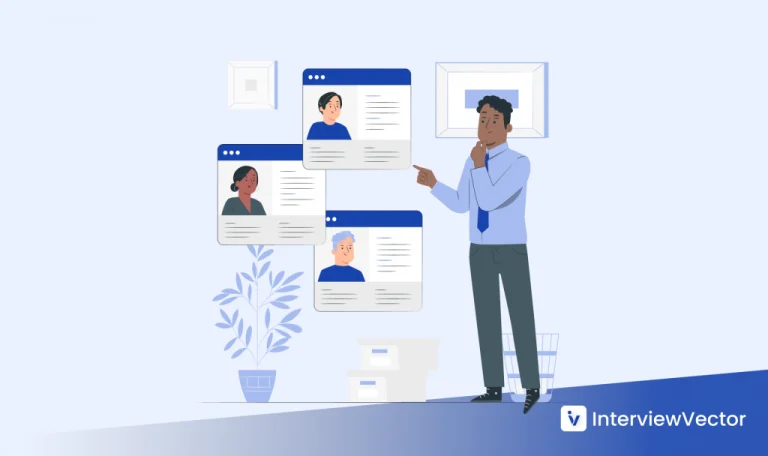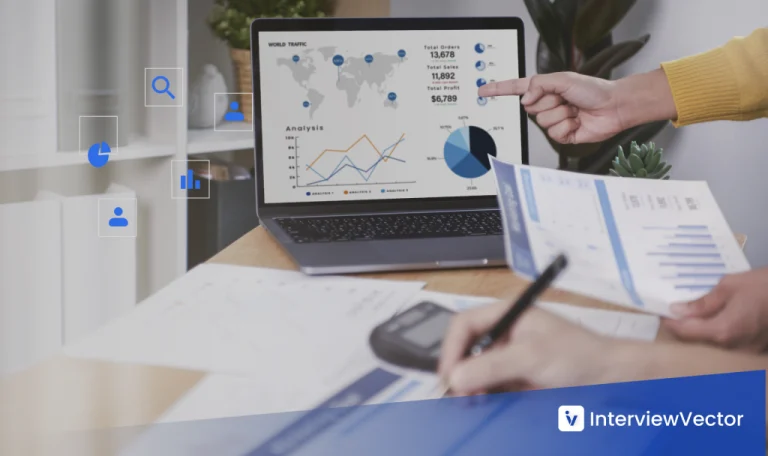Introduction
Preparing for technical interviews can be extremely intimidating, especially if you don’t know what to expect. Technical interviews are intended not merely to examine your coding skills, be it for a position of software developer at a startup or a position of data scientist at a great tech company. Nowadays, recruiters look for a mixed skill set of problem-solving skills, structured thinking, fundamentals of system design, and decision-making ability in real-time under pressure.
In this ultimate guide for technical interviewing, we have gathered the most frequently asked questions and their answers, detailed interview-type formats segregated by roles, and preparation strategies adopted by successful candidates. We provide all the confidence codes you need, from coding challenges to system design.
What is Technical Interviewing?
Technical interviewing consists of evaluating a candidate’s technical capabilities through technical interviewing questions that include tests and problem-solving assignments. Hiring employers conduct Technical interviews specifically to evaluate qualified job candidates who need intensive technical skill sets like software engineering, data science, and IT.
The process generally includes:
- Coding Challenges: Job candidates must address problems directly in real time using whiteboards or online coding interfaces.
- System Design: As part of the assessment process, candidates must design systems or architectures to show their capability in solving complex technical problems.
- Knowledge Assessments: Job-specific questions about algorithms and data structures, alongside programming languages and frameworks, are included.
- Practical Tests: Evidence of practical expertise emerges when candidates execute actual operational scenarios coupled with simulations during the assessment period.
- Behavioral Interviews: Candidates need to show their approach to technical issues combined with their methods for working within teams.
Purpose and Importance of Technical Interviewing
Technical interviewing stands as the main modern hiring tool that connects learned concepts with actual, practical problem-solving in the real world. The main objective of technical interviewing is to determine how well candidates handle coding tasks and system design while resolving technical issues in actual work situations. The employer can evaluate candidate problem-solving abilities and solution optimization, along with communication skills, by observing their work during hands-on exercises and whiteboard sessions and live coding challenges.
Technical interview software evaluates soft skill attributes that include communication ability and collaboration competence, and adaptability because these competencies match the requirements of working in flexible modern settings. The assessment process helps organizations verify that new hires possess essential technical skills and cultural compatibility with their teams. The combination of skill assessments for technological ability along with interpersonal competencies enables organizations to make data-based recruitment choices that result in innovative and effective long-term success. An online technical interview platform teams with the ability to confront complex projects successfully, thus enabling new employees to join forces with a productive, forward-thinking team.
What are the different types of Technical Interviews?
Technical interviews exist in different formats that measure specific technical competencies of candidates.
Phone/Online Screenings:
Recruiting staff uses these preliminary examinations to determine both technical competencies and spoken communication abilities. The first stage of candidate selection helps recruiters identify suitable applicants who will progress to additional interview steps.
Coding Challenges/Online Assessments:
Job candidates perform programming assignments and algorithm-based problems through coding interfaces in real-time. Problem-solving abilities, together with efficiency and data structures and algorithms, are evaluated during this phase.
Whiteboard Interviews:
These interviews need to be either conducted face-to-face or through shared virtual whiteboards where logical reasoning, code structure, and system design get evaluated. The assessment process reveals how applicants structure their thinking and handle challenging problems without preparation.
Pair Programming Sessions:
During pair programming sessions, candidates work alongside interviewers through a shared coding exercise, which reveals their teamwork skills and code writing abilities as well as their communication techniques during actual coding sessions.
System Design Interviews:
The sessions target senior candidates to evaluate their system architecture abilities for creating scalable and efficient systems. The interviews require talks about design choices alongside scalability issues and performance evaluation aspects.
How to prepare for technical interviewing?
Being a technical interviewer is not what everyday people think it is. Technical interviewing questions have more to them than finding candidates, going through their CVs, and passing on offer letters. As the name suggests, the people and panel interviewing for technical positions should have a basic knowledge of the field. In addition to having technical knowledge, they should also have good soft skills. Since interviewers go through mounts of applications every day and meet tens of applicants, they must possess qualities like being empathetic, open-minded, and persistent.
Here are some of the basic traits that a technical interviewer must have, be it inside an organization or an online coding interview platform:-
Up-to-date Industry Knowledge
The IT industry is constantly evolving, requiring its core following of engineers and technology experts to stay updated on the latest changes and developments. Being a technical interviewer, one has to be up-to-date on all the related information so that one can question the available candidates in the talent pool and not overlook the up-and-coming talents in the field.
Technical Communication
In order to interview a candidate, be it in person or through an online coding interviewing platform, the interviewer needs to know how to thread the technical jargon together to make it sound tough yet comfortable for the candidate to answer. Technical interviewing examples is a core trait that an interviewer and interviewee connect on, on an intellectual level, and helps them ease into the process.
Field Experience and Building Relationships
Being up-to-date on industry knowledge and knowing how to communicate in the technical jargon are good enough for online technical interview platform to connect with the applicants but what really sets the cherry on top is having field experience. Imagine sitting down for an interview and the next thing you get to know is that your interviewer has worked in the same sector as you did! That just makes things a lot better already.
Making the candidate feel comfortable is just as important as making them feel worthy of the position. Reviewing a candidate’s CV is a way of acknowledging their qualifications and the amount of time they’ve spent in the field but connecting with them on a personal level, be it having worked in the same sector, under the same roof, under the same manager or something like that… trust me, it helps!
Be Patient
“Patience is a virtue” – William Langland
It is easy to forget how patience is a key component to any successful venture. As a technical interviewer, one must not forget that keeping patience or losing it decides if the future will be secure or ruined. Having to find a technical talent because you have a deadline or holding out on finding the right talent despite the deadline makes all the difference.
Qualities and Traits that are assessed in a Tech Interview
Your role during an interview extends beyond skill assessment because you need to determine technical proficiency and adaptability to existing team processes and problem-solving capabilities. The following assessment questions evaluate candidate tool mastery alongside process comprehension and their ability to think critically during real-world situations.
- Assessing Tool Proficiency
Knowing how well candidates understand the tools and systems your organization uses stands as a vital requirement for proper candidate evaluation. Here are some examples:
- Which set of programming languages do you excel at and why do you excel at them?
- Please describe the specific limitations of your preferred programming language, together with the methods you employ to overcome them.
- Please list the scripting languages you used, together with their application context.
- Which software tools do you prefer most when performing design work, and how have you implemented them in past projects?
- What product management tools did you use in your work? What methods do you use to determine how these tools scale for bigger workgroups?
What to Look For: Job candidates should show practical experience coupled with knowledge-based preference selection and proficiency in standard industry tools.
- Evaluating Process Understanding
A job candidate’s method for handling work tasks directly affects their fit within your team structure. Use these questions to gauge their methodology:
- Explain how you would handle the transition of a product from development through to production deployment.
- Which statistical methodologies and modeling approaches do you use most often and why do you choose them?
- Can you break down the complete process of making decision trees?
- What percentage of your development efforts focus on unit testing and what steps do you use to validate its success?
- What UX framework do you like most and what role did it play in your past design choices?
What to Look For: Ask candidates to present structured systematic information that demonstrates their capability to optimize operational flow while upholding quality standards and matching your company’s requirements.
- Testing Problem-Solving and Critical Thinking
Through situational questions, you can assess candidates’ methods to tackle issues and their ability to think critically about their work.
- What methods do you use to recognize essential end-user requirements throughout product development stages?
- What was the biggest dataset you have processed? What method did you use to handle empty data points?
- When analyzing data what steps do you take to handle outliers?
- Talk about an update you handled that was difficult and required debugging throughout the project. What was your process?
- What one modification would you make to a favorite product along with your justification for this change?
What to Look For: Job applicants who demonstrate effective issue resolution alongside analytical competence and innovative approaches using concrete industry examples will get the best response.
Your questionnaire selection will help you evaluate technical capabilities while revealing how applicants would manage your operational needs. By combining tool-based with process-focused and situational questions during your interview, you will gain the necessary skills to identify the ideal team member.
Technical Interviewing Questions & Answers [Examples]
1. What programming languages are you most familiar with?
Answer: My experience includes extensive work with Python and Java, along with JavaScript. The prior positions I held involved using Python to automate and analyze data and Java for building scalable back-end systems, alongside JavaScript for front-end development. These languages suit me well for work purposes and I take pleasure in learning additional languages when needed. My ability to adjust between programming languages allows me to swiftly join new technical frameworks and project specifications.
2. Describe the troubleshooting process you’d follow for a crashing program.
Answer: My first step in program crash troubleshooting involves duplicating the failure to understand its root causes. I examine error logs before identifying the problematic element. I employ debugging tools to move through code lines while checking for standard problems, which include unhandled exceptions and memory leaks. After finding the root cause, I conduct tests in a controlled setting before implementing the fix. The systematic methodology reduces system downtime while guaranteeing program reliability.
3. How can you debug a program while it’s being used?
Answer: Real-time monitoring and remote debugging tools, together with logging, provide me the ability to track errors without interrupting user interaction. I implement alerts for vital problems together with temporary component disablement through feature flags. The method enables quick issue diagnosis to deploy fast responses or controlled feature rollouts that maintain user operations unaffected.
4. What is your field of expertise and what would you like to learn more about?
Answer: I specialize in complete web development through Python and JavaScript framework applications. I lead in creating backend infrastructures scalable at scale, together with user-friendly front-end interfaces. I am actively interested in studying cloud-native solutions along with DevOps operations, especially focusing on container orchestration and microservices. My ongoing learning process enables me to adapt to changing technologies which leads to enhanced contributions in advanced projects.
5. Have you implemented significant improvements to IT infrastructure? What were they, and how did you implement them?
Answer: The project management responsibility for legacy system migration to microservices architecture fell under my leadership in my previous position. Our system transition allowed better scalability and cut down maintenance periods while making updates more efficient. I started my work by studying our workflow operations before implementing Docker as a containerization tool with Kubernetes for orchestration implementation. Our team split monolithic structures into smaller components while conducting extensive testing which created a better and stable IT infrastructure.
6. What’s the most effective way to gather user and system requirements?
Answers: The most beneficial method for gathering requirements involves working together with stakeholders. The first step involves conducting interviews with stakeholders and surveys and observing users to grasp business targets and end-user requirements. System logs together with performance data help me identify technical constraints for the system. The integration of qualitative information with quantitative results allows me to build an extensive requirements document that leads development toward successful outcomes.
7. Describe a time you had to explain technical details to a non-technical audience. How did you modify your presentation?
Answers: A project update meeting required me to present our system architecture to the marketing team. Simple analogies substituted complex jargon while visuals including flowcharts and infographics together with technical term relationships to everyday terminology helped me communicate with the audience. My presentation focused on outcomes and benefits instead of detailed information to help the audience understand the positive effects our technical decisions had on their business goals and the strategic plan.
8. Where do you place most of your focus when reviewing somebody else’s code?
Answers: As my priority during code review I ensure to evaluate three key aspects: clarity, efficiency and maintainability. I examine documentation and verify technical adherence to standards and review the complete composition of the solution. My examination includes checking for bugs together with edge cases and optimization possibilities. I concentrate on these core areas as they produce functional code that works well for future colleagues through its scalability and easy maintenance capabilities.
9. What did you find most challenging about this assignment? What resources did you use to complete the assignment?
Answers: Integrating different data format APIs proved to be the biggest challenge when developing a cohesive user interface. I faced problems due to inconsistent response times, together with data mismatches. I solved this challenge by referring to official API documentation and consulting both developer communities online and technical blogs. To confirm the solution’s reliability, I implemented debugging tools and tested frameworks, which helped me examine problems and verify my work.
10. What are your strengths and weaknesses as a developer?
Answers: I feel my ability to convert complicated and tedious tasks into small bits and pieces and plan forward in a micro way, one task at a time, is my biggest asset. I work very well with other teams with both technical and non-technical backgrounds because I feel diverse perspectives can be achieved through teamwork. When it comes to my weaknesses, I feel I tend to overdeliver things by creating layers and tools that are not asked for the task. Also, I often work towards achieving perfection, which might pile more work on me. However, I have worked to solve it habit and deliver exactly what is asked.
11. How do you keep your technical skills up to date?
Answers: I regularly get my string of problems solved from LeetCode and HackerRank; I also follow engineering blogs from leading tech companies. I am an active member in several developer communities, exploring new tools, and keep attending workshops and webinars organised by Interview Vector to keep myself updated.
12. Which tools do you use for version control and team collaboration?
Answers: Git is my way to do version control, with GitHub and GitLab managing my repositories and code review. Slack, Jira, and Confluence are how I collaborate and stay aligned with the teams. On the local level, VS Code with Git integration is what I use, and for spinning up dev environments, Docker is the solution, especially if I’m working with a cross-functional team.
Things to Consider Before Your Technical Interview
Technical interviewing tests are more than just about coding. They assess a candidate’s preparation, clarity, and mindset towards the job role. Here’s a condensed checklist to ensure you’re ready:
1. Review the Job Description
Determine primary skills required by the job-whether it’s Python, React, SQL, or systems design-and focus your prep accordingly. The more you focus your study on the primary requirements of the position, the more tailored and purposeful your responses will be; otherwise, they will probably sound like guesses.
2. Practice 2-3 DSA Problems per Day
Stick to problem areas such as arrays, hashmaps, recursion, linked lists, and trees. Use online coding interview platforms like LeetCode to focus on recognizing patterns rather than solving individual problems.
3. Prepare STAR-Based Stories
Get ready to write 3 to 4 short anecdotes using the STAR format (Situation, Task, Action, Result) that highlight accomplishments in projects, debugging issues, teamwork, and leadership. These anecdotes provide you with an upper hand in behavioral interviews.
4. Go Over System Design Basics (Mid/Senior)
Review load balancing, caching, databases, scaling, microservices, and common architectures like chat applications or URL shorteners. Practice clearly explaining trade-offs, potentially accompanied by quick diagrams.
5. Book 1-2 Mock Interviews on InterviewVector
These mock technical interviewing sessions allow you to experience real pressure, polish problem-solving skills, communication, and time management while providing feedback unavailable elsewhere, hence fast-tracking your readiness.
Conclusion
In summary, the strategic significance of interviews and modern tech interview platforms is crucial in today’s job market. HR professionals, hiring managers, and talent acquisition experts have a role in shaping the hiring process and driving growth. By utilizing cutting-edge technologies and approaches, businesses can enhance their recruitment strategies, pinpoint talent, stand out in the industry competition, and even offer technical interviews as a service. As technology advances, the future of recruiting appears to be dynamic and revolutionary, with tech interview platforms leading the charge toward excellence in recruitment and success in the era.














